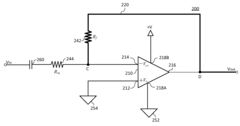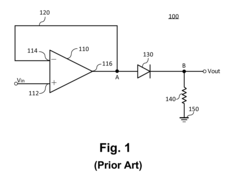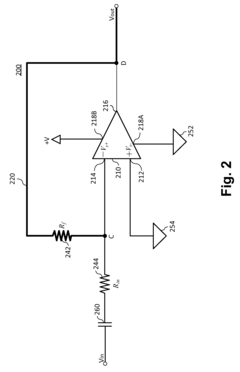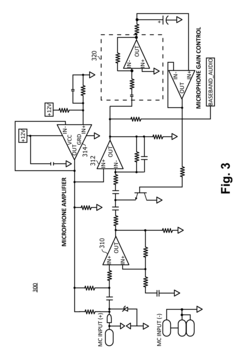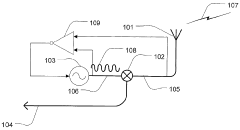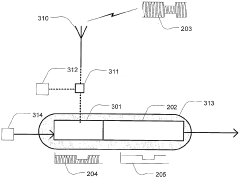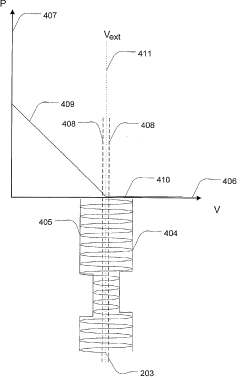Half Wave Rectifiers: Applications in Mobile Technology
JUL 15, 20259 MIN READ
Generate Your Research Report Instantly with AI Agent
Patsnap Eureka helps you evaluate technical feasibility & market potential.
HWR Tech Background
Half-wave rectifiers have played a crucial role in the evolution of mobile technology, serving as fundamental components in power supply circuits. The development of these devices can be traced back to the early 20th century when vacuum tube diodes were first used for rectification purposes. As semiconductor technology advanced, solid-state diodes replaced vacuum tubes, leading to more compact and efficient rectifier designs.
The primary function of a half-wave rectifier is to convert alternating current (AC) into pulsating direct current (DC), which is essential for powering electronic devices. In the context of mobile technology, this conversion process is vital for charging batteries and supplying power to various internal components. The progression of half-wave rectifiers has been closely tied to the miniaturization and increased energy efficiency demands of mobile devices.
Throughout the history of mobile technology, half-wave rectifiers have undergone significant improvements. Early mobile phones relied on simple half-wave rectifier circuits for battery charging, often resulting in inefficient power conversion and longer charging times. As mobile devices became more sophisticated and power-hungry, the need for more advanced rectification techniques grew.
The introduction of fast-recovery diodes and Schottky diodes marked a significant milestone in half-wave rectifier technology for mobile applications. These components offered lower forward voltage drops and faster switching speeds, leading to improved efficiency and reduced power loss during the rectification process. This advancement was particularly crucial as mobile devices began to incorporate more complex features and higher-capacity batteries.
In recent years, the focus has shifted towards developing ultra-low-power rectifiers to support emerging technologies such as energy harvesting in IoT devices and wireless charging systems for mobile phones. These applications require highly efficient rectification to maximize the utilization of small amounts of captured energy or wirelessly transmitted power.
The ongoing trend in half-wave rectifier technology for mobile applications is the integration of advanced materials and novel circuit designs. Researchers are exploring the use of wide-bandgap semiconductors, such as gallium nitride (GaN) and silicon carbide (SiC), to create rectifiers with even higher efficiency and power density. Additionally, the development of active rectification techniques using MOSFETs or other controlled switches aims to further reduce power losses and improve overall system performance.
As mobile technology continues to evolve, the demands on power management systems, including half-wave rectifiers, are expected to increase. Future developments may focus on enhancing rectifier performance under varying load conditions, improving thermal management, and integrating smart control features to optimize power conversion based on device usage patterns and battery health.
The primary function of a half-wave rectifier is to convert alternating current (AC) into pulsating direct current (DC), which is essential for powering electronic devices. In the context of mobile technology, this conversion process is vital for charging batteries and supplying power to various internal components. The progression of half-wave rectifiers has been closely tied to the miniaturization and increased energy efficiency demands of mobile devices.
Throughout the history of mobile technology, half-wave rectifiers have undergone significant improvements. Early mobile phones relied on simple half-wave rectifier circuits for battery charging, often resulting in inefficient power conversion and longer charging times. As mobile devices became more sophisticated and power-hungry, the need for more advanced rectification techniques grew.
The introduction of fast-recovery diodes and Schottky diodes marked a significant milestone in half-wave rectifier technology for mobile applications. These components offered lower forward voltage drops and faster switching speeds, leading to improved efficiency and reduced power loss during the rectification process. This advancement was particularly crucial as mobile devices began to incorporate more complex features and higher-capacity batteries.
In recent years, the focus has shifted towards developing ultra-low-power rectifiers to support emerging technologies such as energy harvesting in IoT devices and wireless charging systems for mobile phones. These applications require highly efficient rectification to maximize the utilization of small amounts of captured energy or wirelessly transmitted power.
The ongoing trend in half-wave rectifier technology for mobile applications is the integration of advanced materials and novel circuit designs. Researchers are exploring the use of wide-bandgap semiconductors, such as gallium nitride (GaN) and silicon carbide (SiC), to create rectifiers with even higher efficiency and power density. Additionally, the development of active rectification techniques using MOSFETs or other controlled switches aims to further reduce power losses and improve overall system performance.
As mobile technology continues to evolve, the demands on power management systems, including half-wave rectifiers, are expected to increase. Future developments may focus on enhancing rectifier performance under varying load conditions, improving thermal management, and integrating smart control features to optimize power conversion based on device usage patterns and battery health.
Mobile Market Demand
The mobile technology market has witnessed exponential growth in recent years, driven by increasing consumer demand for smartphones, tablets, and other portable devices. This surge in demand has created a significant market for half wave rectifiers, which play a crucial role in power management and signal processing within mobile devices.
Half wave rectifiers are essential components in mobile technology, particularly in power supply units and battery charging systems. As mobile devices become more sophisticated and power-hungry, the need for efficient power management solutions has intensified. This has led to a growing demand for advanced half wave rectifier designs that can deliver improved energy efficiency and performance in compact form factors.
The global smartphone market, a key driver for half wave rectifier demand, continues to expand. Despite recent market saturation in some regions, emerging markets in Asia, Africa, and Latin America present substantial growth opportunities. These markets are experiencing rapid adoption of smartphones and other mobile devices, fueling the demand for components like half wave rectifiers.
In addition to smartphones, the proliferation of Internet of Things (IoT) devices and wearable technology has further expanded the market for half wave rectifiers. These devices often require miniaturized power management solutions, creating new opportunities for innovative half wave rectifier designs that can meet the stringent size and power efficiency requirements of these applications.
The automotive industry's shift towards electric and hybrid vehicles has also contributed to the growing demand for half wave rectifiers. As vehicles incorporate more advanced electronics and infotainment systems, the need for efficient power management solutions, including half wave rectifiers, has increased significantly.
Market trends indicate a growing preference for integrated power management solutions that combine multiple functions, including half wave rectification, into single-chip solutions. This trend is driven by the need for space-saving designs and improved overall system efficiency in mobile devices.
The increasing focus on renewable energy and sustainable technologies has also created new market opportunities for half wave rectifiers. Solar-powered mobile chargers and other portable renewable energy solutions often incorporate half wave rectifiers as part of their power conversion systems.
As 5G networks continue to roll out globally, the demand for mobile devices capable of supporting these high-speed networks is expected to rise. This technological shift is likely to drive further innovation in mobile device components, including half wave rectifiers, to meet the power management challenges associated with 5G technology.
Half wave rectifiers are essential components in mobile technology, particularly in power supply units and battery charging systems. As mobile devices become more sophisticated and power-hungry, the need for efficient power management solutions has intensified. This has led to a growing demand for advanced half wave rectifier designs that can deliver improved energy efficiency and performance in compact form factors.
The global smartphone market, a key driver for half wave rectifier demand, continues to expand. Despite recent market saturation in some regions, emerging markets in Asia, Africa, and Latin America present substantial growth opportunities. These markets are experiencing rapid adoption of smartphones and other mobile devices, fueling the demand for components like half wave rectifiers.
In addition to smartphones, the proliferation of Internet of Things (IoT) devices and wearable technology has further expanded the market for half wave rectifiers. These devices often require miniaturized power management solutions, creating new opportunities for innovative half wave rectifier designs that can meet the stringent size and power efficiency requirements of these applications.
The automotive industry's shift towards electric and hybrid vehicles has also contributed to the growing demand for half wave rectifiers. As vehicles incorporate more advanced electronics and infotainment systems, the need for efficient power management solutions, including half wave rectifiers, has increased significantly.
Market trends indicate a growing preference for integrated power management solutions that combine multiple functions, including half wave rectification, into single-chip solutions. This trend is driven by the need for space-saving designs and improved overall system efficiency in mobile devices.
The increasing focus on renewable energy and sustainable technologies has also created new market opportunities for half wave rectifiers. Solar-powered mobile chargers and other portable renewable energy solutions often incorporate half wave rectifiers as part of their power conversion systems.
As 5G networks continue to roll out globally, the demand for mobile devices capable of supporting these high-speed networks is expected to rise. This technological shift is likely to drive further innovation in mobile device components, including half wave rectifiers, to meet the power management challenges associated with 5G technology.
HWR Challenges
Half wave rectifiers (HWRs) face several significant challenges in their application to mobile technology, primarily due to the unique demands of portable devices and the rapidly evolving nature of the mobile industry. One of the foremost challenges is power efficiency. Mobile devices rely heavily on battery life, and any power conversion process must be as efficient as possible to maximize the device's operational time. HWRs, by their nature, only utilize half of the AC cycle, which can lead to lower efficiency compared to full-wave rectifiers. This inefficiency can result in increased power consumption and heat generation, both of which are critical concerns in compact mobile devices.
Another challenge is the issue of ripple voltage. HWRs produce a pulsating DC output with significant ripple, which can introduce noise into the power supply of sensitive mobile components. This ripple can affect the performance of various circuits within the device, potentially leading to degraded audio quality, display artifacts, or interference with wireless communications. Addressing this issue often requires additional filtering components, which can increase the complexity, cost, and size of the power supply circuit.
Size and integration pose another set of challenges for HWRs in mobile technology. As devices continue to shrink and become more feature-packed, every component must be miniaturized and optimized for space. Integrating HWRs into increasingly compact mobile designs while maintaining their performance and reliability is a significant engineering challenge. This often requires innovative circuit designs and the use of advanced materials and manufacturing techniques.
The dynamic power requirements of modern mobile devices also present a challenge for HWRs. Mobile devices frequently switch between high-power and low-power states, depending on their active functions. HWRs must be able to handle these rapid changes in power demand efficiently, maintaining stable output voltages across a wide range of load conditions. This adaptability is crucial for ensuring consistent performance and protecting sensitive components from voltage fluctuations.
Electromagnetic interference (EMI) is another critical challenge. HWRs can generate electromagnetic noise, which may interfere with the numerous wireless communication systems in mobile devices, such as Wi-Fi, Bluetooth, and cellular radios. Mitigating this EMI while maintaining the rectifier's performance and efficiency requires careful circuit design and shielding techniques.
Lastly, the cost-effectiveness of HWRs in mass-produced mobile devices is a significant consideration. While HWRs are generally simpler and potentially cheaper than full-wave rectifiers, the additional components required to address their limitations (such as filtering for ripple reduction) can offset this cost advantage. Balancing performance, efficiency, and cost in high-volume production environments remains an ongoing challenge for mobile device manufacturers implementing HWR technology.
Another challenge is the issue of ripple voltage. HWRs produce a pulsating DC output with significant ripple, which can introduce noise into the power supply of sensitive mobile components. This ripple can affect the performance of various circuits within the device, potentially leading to degraded audio quality, display artifacts, or interference with wireless communications. Addressing this issue often requires additional filtering components, which can increase the complexity, cost, and size of the power supply circuit.
Size and integration pose another set of challenges for HWRs in mobile technology. As devices continue to shrink and become more feature-packed, every component must be miniaturized and optimized for space. Integrating HWRs into increasingly compact mobile designs while maintaining their performance and reliability is a significant engineering challenge. This often requires innovative circuit designs and the use of advanced materials and manufacturing techniques.
The dynamic power requirements of modern mobile devices also present a challenge for HWRs. Mobile devices frequently switch between high-power and low-power states, depending on their active functions. HWRs must be able to handle these rapid changes in power demand efficiently, maintaining stable output voltages across a wide range of load conditions. This adaptability is crucial for ensuring consistent performance and protecting sensitive components from voltage fluctuations.
Electromagnetic interference (EMI) is another critical challenge. HWRs can generate electromagnetic noise, which may interfere with the numerous wireless communication systems in mobile devices, such as Wi-Fi, Bluetooth, and cellular radios. Mitigating this EMI while maintaining the rectifier's performance and efficiency requires careful circuit design and shielding techniques.
Lastly, the cost-effectiveness of HWRs in mass-produced mobile devices is a significant consideration. While HWRs are generally simpler and potentially cheaper than full-wave rectifiers, the additional components required to address their limitations (such as filtering for ripple reduction) can offset this cost advantage. Balancing performance, efficiency, and cost in high-volume production environments remains an ongoing challenge for mobile device manufacturers implementing HWR technology.
Current HWR Solutions
01 Circuit design for half-wave rectifiers
Half-wave rectifiers are designed to convert alternating current (AC) to pulsating direct current (DC). The circuit typically consists of a diode that allows current to flow in one direction during the positive half-cycle of the AC input, while blocking the negative half-cycle. This results in a pulsating DC output that can be further smoothed using capacitors or other filtering components.- Circuit design and topology: Half-wave rectifiers are designed with specific circuit topologies to convert AC to pulsating DC. These designs often include diodes, transformers, and capacitors arranged in particular configurations to achieve efficient rectification. Various improvements in circuit design aim to enhance efficiency, reduce ripple, and minimize power loss.
- Power supply applications: Half-wave rectifiers are commonly used in power supply units for various electronic devices. They are employed in applications ranging from small consumer electronics to industrial equipment. Recent developments focus on improving power factor correction, voltage regulation, and overall efficiency of power supplies incorporating half-wave rectification.
- Integration with control systems: Modern half-wave rectifier designs often incorporate advanced control systems. These may include microcontrollers or digital signal processors to optimize rectifier performance, implement protection features, and enable adaptive operation based on load conditions. Such integration allows for smarter and more efficient power conversion.
- Miniaturization and packaging: There is a trend towards miniaturization of half-wave rectifier circuits, driven by the demand for compact electronic devices. This involves the development of integrated circuit solutions, the use of surface-mount components, and innovative packaging techniques to reduce the overall size of rectifier modules while maintaining or improving performance.
- Efficiency improvements: Ongoing research focuses on improving the efficiency of half-wave rectifiers. This includes the development of new semiconductor materials for diodes, implementation of synchronous rectification techniques, and optimization of circuit parameters to reduce power losses. These improvements aim to increase overall energy efficiency in power conversion systems.
02 Efficiency improvements in half-wave rectifiers
Various techniques are employed to improve the efficiency of half-wave rectifiers. These may include the use of high-speed switching diodes, optimized circuit layouts to reduce parasitic effects, and the implementation of synchronous rectification techniques. Advanced control algorithms and feedback mechanisms can also be utilized to enhance overall system performance and reduce power losses.Expand Specific Solutions03 Applications of half-wave rectifiers in power supplies
Half-wave rectifiers find applications in various power supply designs, particularly in low-power or cost-sensitive applications. They are used in simple AC-DC converters, battery chargers, and some types of voltage regulators. In certain cases, half-wave rectifiers are combined with voltage doubler circuits to achieve higher output voltages from a given AC input.Expand Specific Solutions04 Integration of half-wave rectifiers in electronic devices
Half-wave rectifiers are integrated into various electronic devices and systems. They can be found in consumer electronics, industrial equipment, and automotive applications. Miniaturization and integration techniques allow for compact designs, often incorporating the rectifier circuit directly onto integrated circuits or as part of larger power management systems.Expand Specific Solutions05 Protection and filtering in half-wave rectifier circuits
To enhance the performance and reliability of half-wave rectifier circuits, various protection and filtering mechanisms are implemented. These may include surge protection devices, EMI/RFI filters, and output smoothing capacitors. Advanced designs may incorporate active power factor correction (PFC) circuits to improve power quality and comply with regulatory standards.Expand Specific Solutions
Key HWR Players
The half wave rectifier technology in mobile devices is in a mature stage of development, with a well-established market and widespread adoption. The global market for this technology is substantial, driven by the ubiquity of mobile devices. Key players in this field include Qualcomm, Intel, and Samsung Electronics, who have significant market share and continue to innovate. These companies, along with others like Huawei and Apple, are constantly improving rectifier efficiency and integration in mobile chipsets. The technology's maturity is evident in its standardization across the industry, with ongoing research focused on miniaturization and power efficiency to meet the evolving demands of mobile technology.
Huawei Technologies Co., Ltd.
Technical Solution: Huawei has invested significantly in developing advanced half-wave rectifier technologies for their mobile devices, with a focus on improving energy efficiency and reducing component size. Their approach integrates high-performance half-wave rectifiers into their Kirin SoCs and dedicated power management chips. Huawei's implementation includes AI-driven power management algorithms that optimize the rectification process in real-time based on usage patterns and environmental factors[8]. The company has also explored the use of silicon carbide (SiC) in their rectifier designs, which offers improved thermal performance and higher voltage handling capabilities compared to traditional silicon rectifiers[10]. Huawei's half-wave rectifiers are designed to support their fast-charging technologies, enabling rapid and efficient power delivery in their smartphones and tablets.
Strengths: AI-driven optimization, advanced material usage (SiC), excellent integration with fast-charging technologies. Weaknesses: Potential limitations due to trade restrictions, may be optimized primarily for Huawei devices.
QUALCOMM, Inc.
Technical Solution: Qualcomm has developed advanced half-wave rectifier designs for mobile technology applications, focusing on improving power efficiency and reducing component size. Their approach integrates half-wave rectifiers into their mobile chipsets, particularly in power management integrated circuits (PMICs). These rectifiers are optimized for low-power operation, crucial for extending battery life in smartphones and other mobile devices. Qualcomm's implementation includes adaptive voltage scaling and dynamic frequency adjustment to minimize power consumption during rectification processes[1][3]. The company has also explored the use of novel materials and fabrication techniques to enhance the performance of half-wave rectifiers in their mobile SoCs, resulting in improved thermal management and reduced electromagnetic interference[5].
Strengths: Highly integrated solution, optimized for mobile devices, excellent power efficiency. Weaknesses: Potentially higher cost due to proprietary technology, may require specific Qualcomm chipsets for full functionality.
Core HWR Innovations
Ac to DC conversion circuit
PatentActiveUS20090080224A1
Innovation
- A diode-less half-wave rectifier circuit utilizing an operational amplifier with a capacitor and resistors in a negative feedback loop, allowing low-level signals to be converted to DC without clipping, thereby extending the dynamic range of rectification.
A method and a device for detection of a first signal superimposed on a second signal
PatentWO2008110169A1
Innovation
- The method employs a half-wave rectifier and envelope detector, utilizing optoelectronic devices like optical electro-absorption modulators or lasers to transform and extract the signal, eliminating the need for expensive high-frequency components and allowing for simpler frequency tuning and easier upgrades.
Power Efficiency
Power efficiency is a critical aspect of half wave rectifiers in mobile technology applications. These rectifiers play a crucial role in converting alternating current (AC) to direct current (DC), which is essential for powering various components in mobile devices. However, the efficiency of this conversion process directly impacts the overall power consumption and battery life of mobile devices.
Half wave rectifiers, by their nature, only utilize one half of the AC waveform, which inherently limits their power efficiency. In mobile technology, where energy conservation is paramount, this limitation presents both challenges and opportunities for innovation. The efficiency of half wave rectifiers in mobile applications typically ranges from 40% to 60%, depending on the specific design and implementation.
One of the primary factors affecting the power efficiency of half wave rectifiers in mobile devices is the voltage drop across the diode. This drop results in power loss, which is converted to heat. In mobile applications, where space is limited and heat dissipation is challenging, this power loss can be particularly problematic. To address this issue, manufacturers often employ Schottky diodes, which have a lower forward voltage drop compared to conventional silicon diodes, thereby improving overall efficiency.
Another consideration in power efficiency is the ripple factor of the output voltage. Half wave rectifiers produce a higher ripple factor compared to full wave rectifiers, necessitating more extensive filtering. This additional filtering requirement can lead to increased power consumption and reduced overall efficiency. Mobile device designers must carefully balance the trade-offs between rectifier simplicity and the need for additional filtering components.
The choice of rectifier topology also significantly impacts power efficiency. While half wave rectifiers offer simplicity and lower component count, their efficiency limitations have led to the exploration of alternative designs in mobile technology. For instance, synchronous rectification, which replaces diodes with actively controlled switches, can substantially improve efficiency by reducing voltage drops and conduction losses.
In recent years, advancements in semiconductor technology have led to the development of more efficient rectifier designs specifically tailored for mobile applications. These include the integration of rectifiers with voltage regulators and power management ICs, which optimize power conversion and distribution within mobile devices. Such integrated solutions not only improve efficiency but also reduce the overall footprint of power management systems in space-constrained mobile devices.
As mobile technology continues to evolve, with increasing demands for longer battery life and faster charging capabilities, the focus on improving the power efficiency of rectifiers, including half wave rectifiers, remains a key area of research and development. Future innovations in this field are likely to center around novel materials, advanced circuit topologies, and intelligent power management algorithms to further enhance the efficiency of power conversion in mobile devices.
Half wave rectifiers, by their nature, only utilize one half of the AC waveform, which inherently limits their power efficiency. In mobile technology, where energy conservation is paramount, this limitation presents both challenges and opportunities for innovation. The efficiency of half wave rectifiers in mobile applications typically ranges from 40% to 60%, depending on the specific design and implementation.
One of the primary factors affecting the power efficiency of half wave rectifiers in mobile devices is the voltage drop across the diode. This drop results in power loss, which is converted to heat. In mobile applications, where space is limited and heat dissipation is challenging, this power loss can be particularly problematic. To address this issue, manufacturers often employ Schottky diodes, which have a lower forward voltage drop compared to conventional silicon diodes, thereby improving overall efficiency.
Another consideration in power efficiency is the ripple factor of the output voltage. Half wave rectifiers produce a higher ripple factor compared to full wave rectifiers, necessitating more extensive filtering. This additional filtering requirement can lead to increased power consumption and reduced overall efficiency. Mobile device designers must carefully balance the trade-offs between rectifier simplicity and the need for additional filtering components.
The choice of rectifier topology also significantly impacts power efficiency. While half wave rectifiers offer simplicity and lower component count, their efficiency limitations have led to the exploration of alternative designs in mobile technology. For instance, synchronous rectification, which replaces diodes with actively controlled switches, can substantially improve efficiency by reducing voltage drops and conduction losses.
In recent years, advancements in semiconductor technology have led to the development of more efficient rectifier designs specifically tailored for mobile applications. These include the integration of rectifiers with voltage regulators and power management ICs, which optimize power conversion and distribution within mobile devices. Such integrated solutions not only improve efficiency but also reduce the overall footprint of power management systems in space-constrained mobile devices.
As mobile technology continues to evolve, with increasing demands for longer battery life and faster charging capabilities, the focus on improving the power efficiency of rectifiers, including half wave rectifiers, remains a key area of research and development. Future innovations in this field are likely to center around novel materials, advanced circuit topologies, and intelligent power management algorithms to further enhance the efficiency of power conversion in mobile devices.
EMI Considerations
Electromagnetic Interference (EMI) is a critical consideration in the application of half-wave rectifiers in mobile technology. As these devices become increasingly compact and powerful, the potential for EMI increases, necessitating careful design and mitigation strategies.
Half-wave rectifiers, while essential for power conversion in mobile devices, can generate significant electromagnetic noise due to their switching nature. This noise can interfere with sensitive components within the device, as well as other nearby electronic equipment. The abrupt current changes during the rectification process create high-frequency harmonics, which can radiate and conduct through power lines and circuit traces.
In mobile technology, EMI from half-wave rectifiers can affect various subsystems. For instance, it may introduce noise in audio circuits, causing audible hum or distortion. In radio frequency (RF) circuits, such as those used in cellular communication, EMI can degrade signal quality and reduce the effective range of the device. Additionally, interference with touchscreen controllers may result in erratic touch response or phantom touches.
To address these challenges, several EMI mitigation techniques are employed in mobile device design. Proper shielding is crucial, often involving the use of conductive enclosures or coatings to contain electromagnetic radiation. Strategic component placement and PCB layout design help minimize coupling between noise sources and sensitive circuits. Implementing ground planes and careful routing of power and signal traces can significantly reduce EMI propagation.
Filtering is another key strategy in EMI reduction. Low-pass filters are commonly used at the output of half-wave rectifiers to suppress high-frequency noise. In some cases, more advanced EMI suppression components, such as ferrite beads or common-mode chokes, may be integrated into the power supply design.
Soft-switching techniques can also be applied to half-wave rectifiers in mobile technology to reduce EMI. By controlling the switching transitions to be less abrupt, the high-frequency content of the EMI can be reduced. This approach, however, must be balanced against efficiency considerations, as softer switching can increase power losses.
Regulatory compliance is a crucial aspect of EMI considerations in mobile technology. Devices must meet stringent electromagnetic compatibility (EMC) standards set by various regulatory bodies worldwide. These standards typically specify limits for both conducted and radiated emissions, as well as immunity to external electromagnetic disturbances.
As mobile technology continues to evolve, with increasing integration of diverse functionalities and higher operating frequencies, EMI considerations for half-wave rectifiers will remain a critical design challenge. Ongoing research in materials science and circuit design techniques promises to yield new solutions for EMI mitigation, enabling the development of more compact, efficient, and reliable mobile devices.
Half-wave rectifiers, while essential for power conversion in mobile devices, can generate significant electromagnetic noise due to their switching nature. This noise can interfere with sensitive components within the device, as well as other nearby electronic equipment. The abrupt current changes during the rectification process create high-frequency harmonics, which can radiate and conduct through power lines and circuit traces.
In mobile technology, EMI from half-wave rectifiers can affect various subsystems. For instance, it may introduce noise in audio circuits, causing audible hum or distortion. In radio frequency (RF) circuits, such as those used in cellular communication, EMI can degrade signal quality and reduce the effective range of the device. Additionally, interference with touchscreen controllers may result in erratic touch response or phantom touches.
To address these challenges, several EMI mitigation techniques are employed in mobile device design. Proper shielding is crucial, often involving the use of conductive enclosures or coatings to contain electromagnetic radiation. Strategic component placement and PCB layout design help minimize coupling between noise sources and sensitive circuits. Implementing ground planes and careful routing of power and signal traces can significantly reduce EMI propagation.
Filtering is another key strategy in EMI reduction. Low-pass filters are commonly used at the output of half-wave rectifiers to suppress high-frequency noise. In some cases, more advanced EMI suppression components, such as ferrite beads or common-mode chokes, may be integrated into the power supply design.
Soft-switching techniques can also be applied to half-wave rectifiers in mobile technology to reduce EMI. By controlling the switching transitions to be less abrupt, the high-frequency content of the EMI can be reduced. This approach, however, must be balanced against efficiency considerations, as softer switching can increase power losses.
Regulatory compliance is a crucial aspect of EMI considerations in mobile technology. Devices must meet stringent electromagnetic compatibility (EMC) standards set by various regulatory bodies worldwide. These standards typically specify limits for both conducted and radiated emissions, as well as immunity to external electromagnetic disturbances.
As mobile technology continues to evolve, with increasing integration of diverse functionalities and higher operating frequencies, EMI considerations for half-wave rectifiers will remain a critical design challenge. Ongoing research in materials science and circuit design techniques promises to yield new solutions for EMI mitigation, enabling the development of more compact, efficient, and reliable mobile devices.
Unlock deeper insights with Patsnap Eureka Quick Research — get a full tech report to explore trends and direct your research. Try now!
Generate Your Research Report Instantly with AI Agent
Supercharge your innovation with Patsnap Eureka AI Agent Platform!
